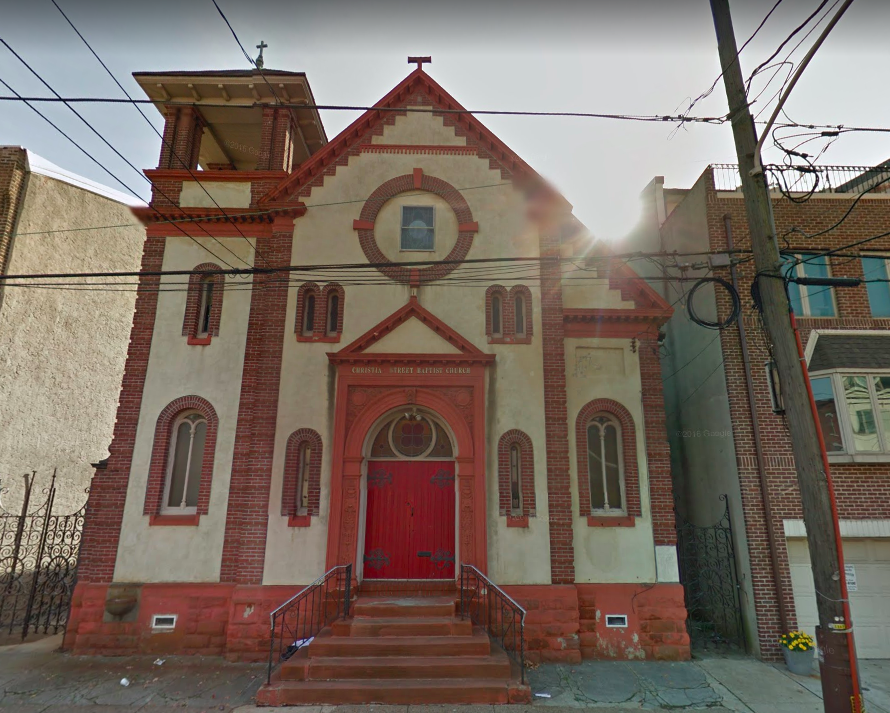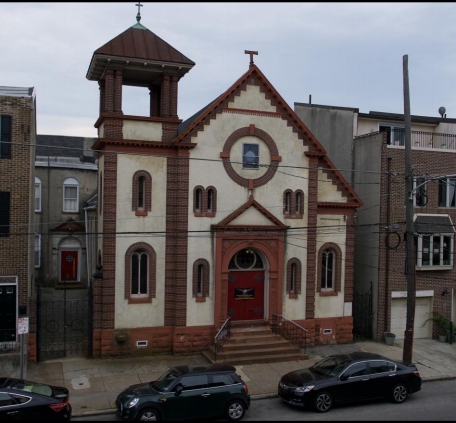Not so Christian Street? Preservationists seek to save Bella Vista church from developer’s wrecking ball

Just a short walk west from the Italian Market, the Christian Street Baptist Church sits nestled mid-block among the surrounding three-story rowhouses. The church’s mix of terracotta, red sandstone, and red brick masonry neatly echoes the architecture of the surrounding blocks.
But it may not do so for much longer. Most of the aging congregation no longer live in the neighborhood and they’ve been struggling with maintenance costs and parking issues. The condition of the 126-year-old building grew so bad that Pastor Clayton Hicks was reduced to tending to his flock in a small room in the rear of the church because the main sanctuary had been overwhelmed by mold and structural deficiencies.
Early this past summer, Hicks put the building up for sale at $1.5 million. In the hot Bella Vista real estate market, it didn’t take long to find a buyer: Ori Feibush, a developer who seems to court controversy wherever he builds.
The sale attracted attention beyond would-be townhome ASK builders. The church is a beloved neighborhood fixture and Oscar Beisert — one of the city’s premier preservation advocates — quickly wrote up a nomination to add the building to the local historic register, protecting it from demolition.
At Friday’s Historical Commission meeting, Beisert explained his reasoning for protecting the building.
“It’s a landmark on its own, but it’s also part of the parade of buildings that lead up to the Italian Market,” said Beisert. He emphasized the church’s history as the only Italian Protestant Episcopal mission in the city, and its efforts to provide aid to the city’s burgeoning Italian population in the late 19th century. Over the decades, the congregation changed from predominantly Italian to almost exclusively African-American.
The Bella Vista Neighbors Association and the Preservation Alliance of Greater Philadelphia support Beisert’s attempt to win historic protections for the building.
But Pastor Hicks, and the dozen members of his flock who attended the commission meeting, view the nomination effort as an existential threat. Their small congregation cannot afford the maintenance of the building and they need the money from the sale to buy a new space.
“They are being told, after they’ve been gentrified out of the neighborhood, that not only can they not exist there, but they can’t exist anywhere else,” said Jeffrey Hill, a representative for Christian Street Baptist. “We do know this nomination will have a severe monetary impact on the value of this property. And if it does take away a third or a half of this property value that will be a travesty for this small African-American congregation and this church built on the backs of washerwomen.”
This clash is but the latest example of the fights that frequently arise when dwindling church attendance meets rising property values. The conflicts have become especially common in Center City and the surrounding historic rowhouse neighborhoods.

In recent years, Historical Commission meetings have frequently been punctuated by raging debates over the future of beloved neighborhood religious icons — like Fishtown’s St. Laurentius, or the Monumental Baptist Church in Spruce Hill — that leave communities fractured.
During Friday’s debate on Christian Street Baptist Church, the opposing sides maintained civility. But Pastor Hicks in particular looked deeply pained by the uncertainty.
“While we were there, we fulfilled our great commission to help people, but now our time there is done,” said Pastor Hicks. “They are so concerned with mortar and stone that they are forgetting what the church is about. We need to move, we need to relocate, and if we aren’t allowed by this commission, you are effectively cutting our ministry off at the knees.”
Numerous members of the congregation spoke up as well, clearly stung by the fact that strangers were suddenly becoming so intimately involved in the future of their institution. These tensions were highlighted by the fact that Christian Street Baptist Church is an African-American church, while all of the people who spoke in favor of preserving it were white and had never taken an active interest in it’s fate before.
“Every year, we have a cook out for the community and for the neighborhood, but no one from the neighborhood ever comes out,” said Minister Michael Stokely, questioning the Bella Vista Neighbors Association’ sudden interest in the building.
Pastor Hicks admitted that he felt the way Bella Vista Neighbors and Beisert had handled the situation seemed “underhanded,” because they hadn’t consulted with the congregation and only acted after the building was put on the market.
But such reactionary efforts to protect buildings have become the norm in the world of Philadelphia preservation. The number of people who regularly file nominations to the historic register can be easily counted on two hands. Due to their small number and skimpy resources, this activist core generally concentrate efforts on buildings they feel to be both worthy and under threat.
Towards the end of the meeting, compromise appeared to be within reach.
Beisert told the commission that after he filed his nomination Feibush called him and requested that he withdrawal it. The developer said he planned demolition for the church, but that he believed parts of the building could be preserved.
Beisert said he declined Feibush’s offer, but seemed to consider the exchange as an example of possibilities open to the congregation beyond selling the building for demolition and, presumably, the construction of townhomes. (The lots the church sits on are zoned for single-family row homes, as is the rest of the block.) He said there was no doubt there would still be a very healthy market for the structure, even with historic protections, given the area’s hot real estate market.
Hill confirmed that Feibush is the buyer. Beisert also offered negotiation, if the Historical Commission continued their ruling until the next month. But the church requested that the commission rule on adding the building to the local register on Friday.
They did not. The commissioners were clearly torn between the plight of Pastor Hicks and his congregation and the imperative of adding the building to the historic register, which many in the body seem to believe it obviously merited.
Instead the commission tried to please everyone. They voted to acknowledge that the nomination is correct, and the building does meet the criteria for historic designation. But they stopped short of actually adding the building to the list and instead continued the case so it would be taken up again at November’s hearing.
Reached for comment on Monday, Feibush said he had been surprised to learn the building hadn’t been added to the local historic registry at Friday’s meeting. He’d since been in touch with Beisert to again offer to preserve the facade. But he said that the church would have to agree to such a compromise and that he wasn’t sure they would, as the proposition could take as much as $600,000 off the sale price.
“I’m certainly open to work with Oscar, because I believe I have a good relationship with him, and with the neighbors, and with the church,” said Feibush. “But the heaviest lift will probably be the church, because they are rightfully expecting a certain number and that number is only possible if the entire site is demolished. That doesn’t sound like it’ll be in the conversation.”
Pastor Hicks couldn’t be reached for follow-up comment on Monday.
Feibush is preserving the facade of the former Royal Theater, on South Street, and says that the project barely pencils out because of it. The Christian Street Church would require a similar outlay from him, but he only plans five or six townhomes for the site. As a result, the only way to make it profitable would be to reduce the sales price of the building. Feibush also claims that preserving the building entirely and converting it to apartments, as was proposed for St. Laurentius, wouldn’t work either.
“I’m very familiar with St., Laurentius and this building does not lay out for that,” said Feibush. “You would probably end up with six apartments across the whole site. It would never work. It would probably be best for everyone, if the church is amenable, to preserve the façade and then build homes behind it. It’s a beautiful building, but there are a lot of beautiful buildings in the city and the challenge is always who pays for that lost income.”
WHYY is your source for fact-based, in-depth journalism and information. As a nonprofit organization, we rely on financial support from readers like you. Please give today.







